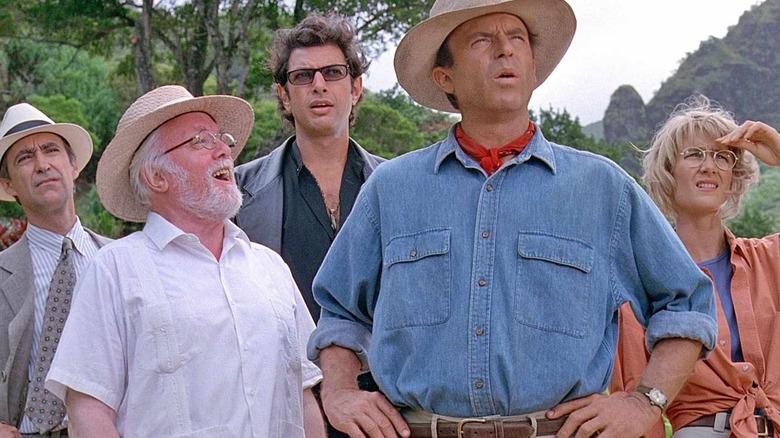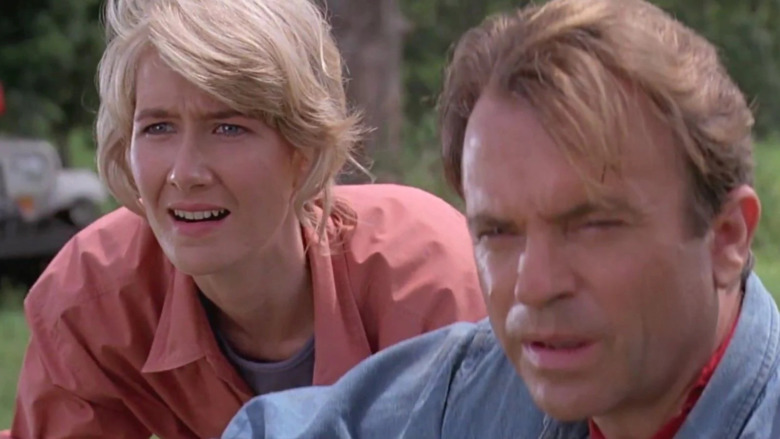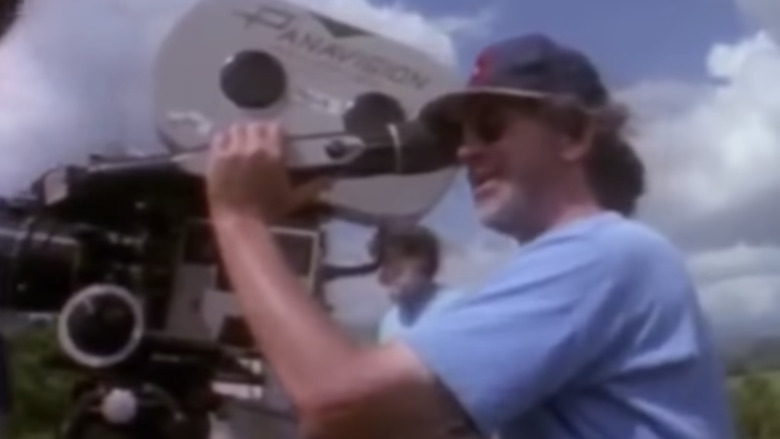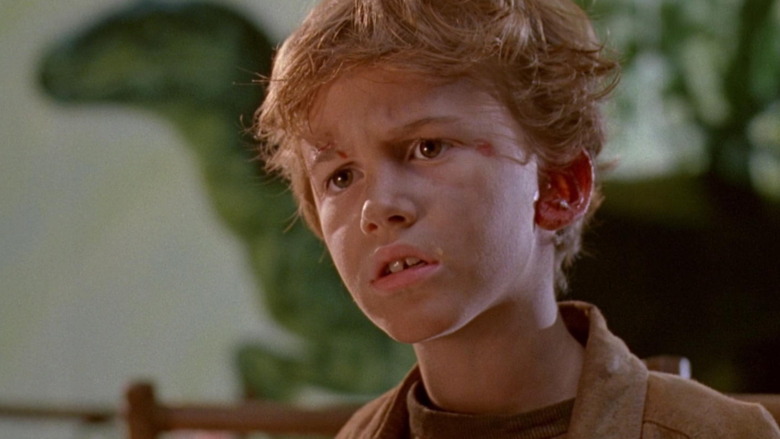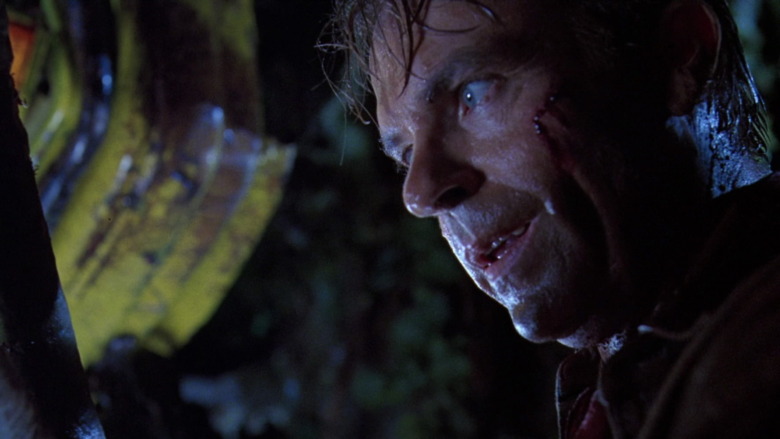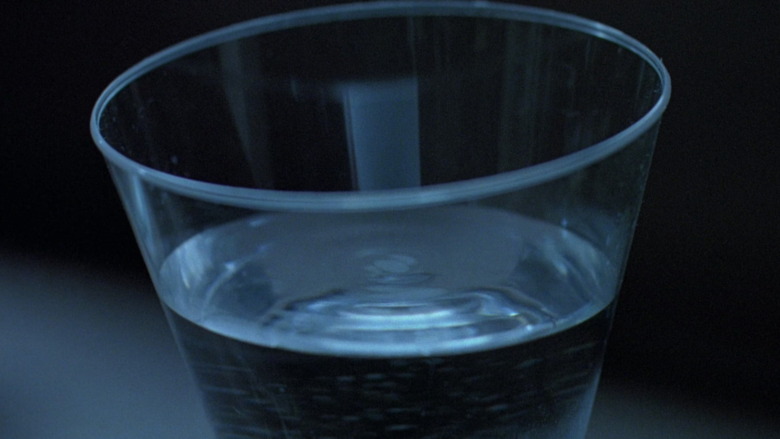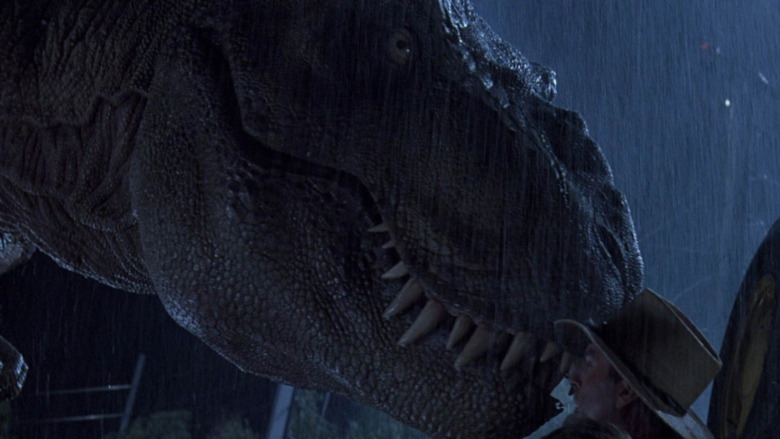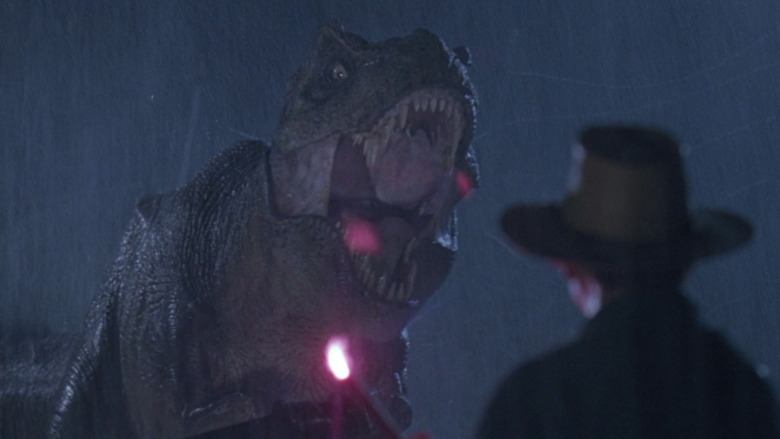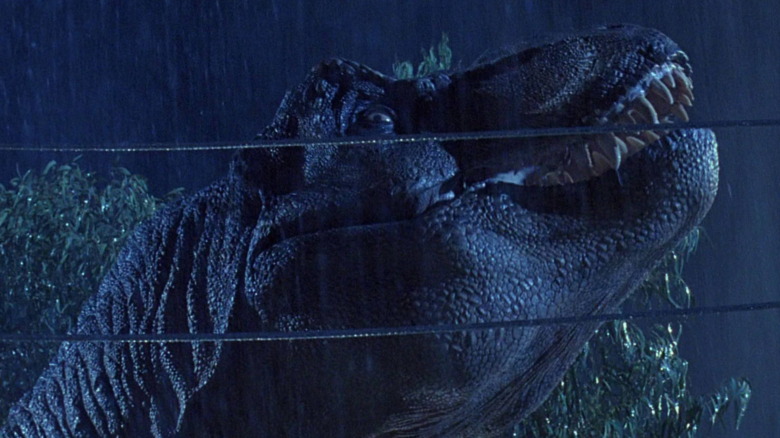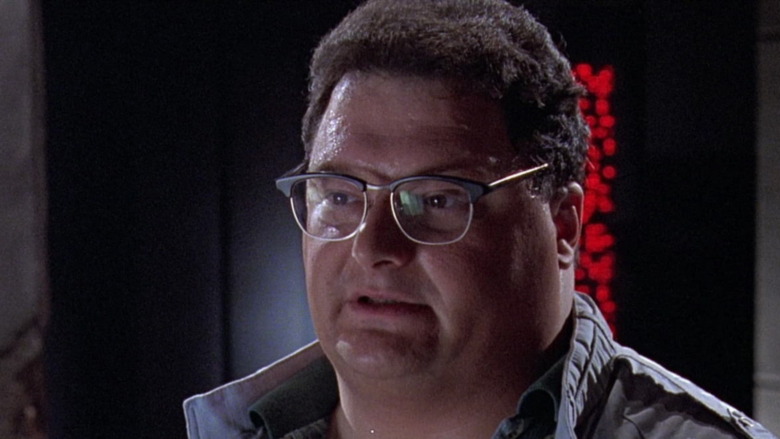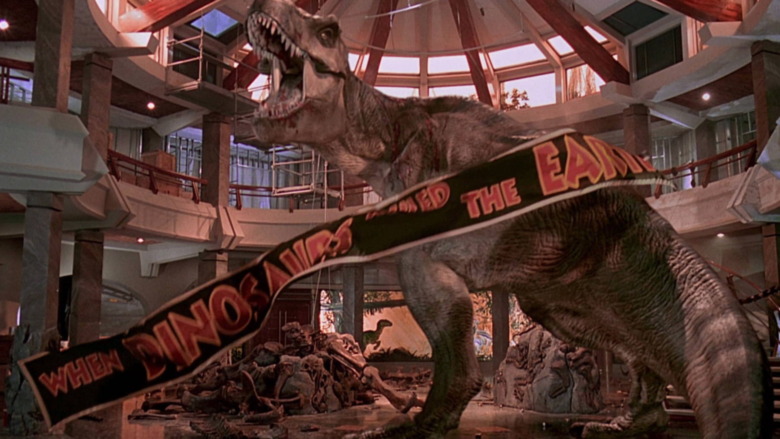What The Final Days On The Set Of Jurassic Park Were Like
Nearly three decades after its release, Steven Spielberg's Jurassic Park remains a Hollywood classic and a remarkable cinematic achievement. Based on the novel by Michael Crichton, Jurassic Park rose to the challenge of depicting lifelike dinosaurs on screen on a level that no film before (or, frankly, since) has accomplished. While it's spawned a series of high-grossing sequels, the original 1993 Jurassic Park is unmatched in provoking a childlike wonder — and justified terror — at a piece of the natural world that no human being has ever experienced outside of the cinema.
While many classic Hollywood films are famously the result of fraught productions haunted by blown deadlines and a cast and crew pushed to the edge of their physical and mental endurance, Jurassic Park is a counterexample, a film that was so meticulously prepared for that it actually wrapped filming ahead of schedule. Even a dramatic and deadly display from Mother Nature herself midway through production barely caused a stutter-step in the making of Jurassic Park. The back half of shooting one of the most technically challenging films of its day was reportedly completed with one disaster after another being narrowly yet safely avoided. So much could've gone wrong and then ultimately didn't — Dr. Ian Malcolm would be baffled.
The Jurassic Park cast had recently survived a historic hurricane
While the final stage of production on Jurassic Park took place on sound stages in California, the first three months of filming had been performed on the Hawaiian island of Kauai. Just before the final day of scheduled shooting, the island was struck by Hurricane Iniki, which would stand for decades as the deadliest and most damaging storm ever recorded on the Hawaiian islands. While the cast and crew of Jurassic Park were able to take shelter their hotel, the hurricane outside claimed six lives and left about $3 billion of damage in its wake.
The Jurassic Park production personnel were confined to the hotel ballroom for seven and a half hours, during which they developed a fast and firm camaraderie. While the hurricane destroyed the roof of the hotel, the ceiling held, and the crew comforted and entertained themselves with a Victoria's Secret catalog (which actor Sam Neill claims is the only thing they had to read) and a flashlight, and director Steven Spielberg told ghost stories to distract from the real terror raging above.
"That experience changed everything," Laura Dern told ABC News in a retrospective celebrating the film's 25th anniversary. "You become a family instantly. We walked through a natural disaster together, and so we were so, so bonded." In the book The Making of Jurassic Park, Steven Spielberg recalls the aftermath of Hurricane Iniki as "the worst devastation [he] had ever personally witnessed."
Spielberg's efficiency put the set-builders on a crunch
By the time Jurassic Park was in production in 1992, Steven Spielberg already had a great deal of experience directing effects-heavy feature films and was familiar with the production obstacles that usually come with them. This time, however, Spielberg seemed dead set on proving that he could deliver a technically complicated spectacle on time.
"I had been on other pictures — 1941, Jaws, and Hook — where the production simply got away from me, and I was dragged behind schedule," says Spielberg in Don Shay and Jodi Duncan's book, The Making of Jurassic Park. "I was determined not to let it happen this time." Spielberg was able to pick up the pace of filming a given scene simply by not shooting as many takes as he might've previously asked for. "The actors knew we were either going to get it by take five or we weren't going to get it," Spielberg told Shay and Duncan, "and everybody rose to the occasion." The production's expediency was also aided by Stan Winston Studios' on-set dinosaur effects performing more reliably than the average animatronics.
The shoot progressed so quickly, in fact, that builders were struggling to meet shortened deadlines for completed sets. "They drove us absolutely nuts," says John Villarino of the art department in The Making of Jurassic Park. Villarino credits his department's exceptional teamwork for being able to complete the work on the compressed schedule.
Actor Joseph Mazzello suffered a minor dino-related injury
In one of Jurassic Park's most suspenseful sequences, young Lex and Tim Murphy (Ariana Richards and Joseph Mazzello) take cover in the kitchen of the park's visitor center to evade a pack of hungry and clever Velociraptors. Throughout production of these scenes, Richards and Mazzello performed against both mechanical raptors operated by puppeteers and actors in complex raptor costumes. The practical raptors hold up brilliantly decades later, but they do have one innate disadvantage over CGI dinosaurs — it's comparably difficult for a computer-rendered dinosaur to bonk an actor on the head.
While shooting Tim's escape from the raptors, a miscue led to an accidental collision between actor Joseph Mazzello and one of the dino puppets. "I was chased by the raptor, and they had him on wheels," Mazzello told Entertainment Weekly in a retrospective interview. "They were rolling after me, and I was supposed to go left, and it's supposed to go right. The one time I go left, I turn around, and it's following me left, and the claw just hit me right in the head."
Mazzello was left dizzy and bruised by his encounter with the raptor, a situation made all the more surreal when, in consolation, director Steven Spielberg led the crew in singing "Happy Birthday" to the frazzled young actor, as Mazzello had turned nine years old that very day.
Sam Neill let the crew basically drop a truck on him
Many of the outdoor scenes in Jurassic Park were actually accomplished on indoor sound stages during the final leg of the film's production. For instance, after the power goes out on Isla Nublar, Dr. Alan Grant (Sam Neill) and young Tim Murphy find themselves stuck in a tall tree with their SUV perched precariously on the branches above them. As the branches buckle under the weight of the vehicle, Alan and Tim must climb swiftly down the tree before the car forces them to the ground even faster.
Shooting for this scene took place on Universal's Stage 27, on a 50-foot-tall, artificially constructed tree. Steven Spielberg wanted to increase the danger to 150 feet, so Michael Lantieri's special effects department dressed the tree with hydraulically controlled branches that would give way on command, and they shot the car chasing Neill and Mazzello down the massive trunk three times. The chase ends with the pair reaching the ground just before the car's momentum is broken by a branch immediately above them. In order to sell this, Neill consented to letting the crew drop the car onto a thick branch (actually made of steel), six inches over his head.
"I never felt I was in danger," says Neill in the book The Making of Jurassic Park. "This was a top crew, and I relied on their judgement. If they said the car was going to stop ... I was prepared to take their word for it."
One of Jurassic Park's most iconic images was among its most challenging
Jurassic Park contributed countless distinctive images to the canon of American cinema, most of them expensive effects shots of the film's many practical and digital dinosaurs. However, one of the film's most iconic shots is one if its simplest — a cup of water rippling on a car dashboard, presaging the approach of an enormous Tyrannosaurus rex. But just because the effect looks simple, that doesn't mean it was easy to accomplish.
According to the 1995 documentary The Making of Jurassic Park, director Steven Spielberg conceived of this shot after noticing his rearview mirror shaking to the music of Earth, Wind, and Fire blasting from his car stereo. Spielberg felt that something like this would make an evocative introduction for the T. rex in the film, and he asked Michael Lantieri of the special effects department if he could create circular ripples in a cup of water to represent the T. rex's footsteps. Lantieri answered, "Sure, we can do that," but in fact, he had no idea whether or not they could.
In the documentary, Lantieri refers to the vibrating water glass as "the most difficult gag in the film," as he and his department racked their brains and tried all sorts of devices to achieve the desired effect. He eventually found a very low-tech solution — attaching a guitar string to the bottom of the dashboard and plucking it from underneath the car.
A massive robotic T. rex was the star of the show
To accomplish the complicated special effects in Jurassic Park, some of the outdoor sets that had been constructed and shot during location shooting on Kauai were reproduced on massive sound stages in California. The grandest of these sets would be the fence outside the Tyrannosaurus rex enclosure, the site of one of the film's most thrilling set pieces. In this sequence, the scientists, children, and the blood-sucking lawyer sent to test out the Jurassic Park tour are caught outside at night during a power outage and find themselves hunted by a hungry T. rex.
For this scene, legendary special effects artist Stan Winston and his team constructed a full-scale animatronic T. rex that stood 20 feet tall and weighed approximately 13,000 pounds. While wide shots of the T. rex running were accomplished using CGI, this beast could move, capable of swiveling at 90 inches per second. The close-ups of her inspecting the vehicle carrying young Lex and Tim Murphy, blowing the hat off of Alan Grant, and countless other shots were captured in-camera using practical effects. The T. rex even broke a tooth filming the scene in which she attempts to take a bite out of the Murphy kids and bumps her nose against the SUV's transparent plexiglass roof instead. The puppeteers originally planned to precisely program all of the T. rex's movements via computer, but they found that they got a more natural performance out of her by manually operating the controls for most takes.
The T. rex got caught in the rain ... indoors
From the beginning of the design process for the animatronic dinosaur, special effects artist Stan Winston knew that the T. rex's big scene would take place in the torrential downpour of a tropical storm. When attempts to waterproof the foam rubber skin around the massive robotic beast proved insufficient, Winston planned instead for the T. rex to avoid direct contact with water during shooting. But when the dino was finally called for her close-up after more than a year of preparation, the man-made weather on the set wasn't cooperative.
"We ended up drenching this thing," Winston told authors Don Shay and Jodi Duncan for their book The Making of Jurassic Park, "which created enormous complications." The T. rex was rained upon almost constantly while cameras were rolling, and the foam rubber absorbed gallons of water, shorting out the electronics and adding to the machine's already massive weight. As seen in the official 1995 behind-the-scenes documentary (also called The Making of Jurassic Park), this would lead to the T. rex literally shivering from the strain of moving its waterlogged body. Against Winston's recommendations, director Steven Spielberg would call for multiple takes in a row between drying the T. rex off, which needed to be done often. "It was hellacious for us," says Winston in the book, "but the T. rex looked great on film — and that's what really mattered."
Despite the delays, Spielberg actually managed to wrap shooting the T. rex chase four days ahead of schedule.
A special effects technician was nearly crushed by the Tyrannosaurus
Before Stan Winston Studios' life-sized, hydraulic T. rex puppet could report to Warner Bros. Stage 16 for her famous chase scene, her foam rubber skin had to be removed for transport, which meant that it would have to be re-applied before filming. Some portions of the robotic dinosaur's skin could only be glued onto her frame from the inside while the hydraulics were engaged to keep her head in an upright position. That meant, should the robot lose power, the head would lower, and the mechanisms inside would contract, potentially crushing anyone inside.
Alan Scott, the brave crew member who volunteered to crawl inside the T. rex armature to complete the work, recalled the experience to the Stan Winston School of Character Arts blog years later. "I'm going to be inside," he remembered saying to a colleague at the time, "and if this thing moves, with all those hydraulics inside, I'm dead."
Suddenly, in a twist torn straight from the film for which the robot was built, the studio suffered a power outage, causing the robotic T. rex to slowly lower its head and its mechanisms to close in around Scott. Scott pulled his body in tight and stayed as small and still as possible until the robot's head had completely lowered, and he was shocked and relieved to find himself intact. Scott's coworkers freed him from inside the belly of the beast, relieved to have avoided a potentially fatal disaster.
Wayne Knight got his face stained purple
The human antagonist of Jurassic Park is Dennis Nedry, the computer programmer who sabotages the park's power and security systems in a failed attempt to smuggle dinosaur embryos off the island. Nedry is portrayed by Wayne Knight, who, according to a contemporary feature article in Empire magazine, Steven Spielberg had cast on the strength of his small role as a cop in 1992's Basic Instinct. By now, Knight was also famous for his role on Seinfeld as Jerry's maniacal neighbor Newman, and he was shooting scenes for that show at the same time as his work on Jurassic Park.
In Knight's final scene in the film, Nedry is stumbling through the rain and mud with his stolen embryos when he encounters a small, seemingly non-threatening Dilophosaurus. The dinosaur sprays him with a purple gunk that blinds him, making him easier prey. And when Knight returned to the set of Seinfeld, he discovered that the dye from the Dilophosaurus' attack had some real-life effects.
"It kind of dyed my face purple," Knight told one of Jurassic Park's dinosaur effects artist, according to an ABC News retrospective. "Yeah," Knight claims the artist replied, "it'll do that." Knight says that the make-up artists on Seinfeld had to try and solve his surprise pigmentation problem before he could shoot his scenes for the show.
The Jurassic Park finale was even bigger than initially planned
The final days of principal photography on Jurassic Park were spent on the climactic confrontation in the visitor center between Grant, Ellie Sattler (Laura Dern), and the Murphy children and the pack of Velociraptors that have stalked them across the compound. Initially, the finale would've featured only the humans and the raptors, with Grant saving the party by using a crane to push a raptor into the mouth of the fossilized T. rex that stands in the middle of the rotunda. However, after being impressed by both the practical T. rex and her computer-generated counterpart being developed by Industrial Light and Magic (ILM), Spielberg determined that the film couldn't end without the real star of the film taking a final bow.
"I think the audience will hate me if the T. rex doesn't come back and make one more heroic appearance," said Spielberg in the 1995 made-for-TV documentary The Making of Jurassic Park. Thus, a new ending was written in which the T. rex would barge into the visitor center and make a meal out of one of the raptors. Rather than actually besting the animals in a fight, the humans merely use the distraction as a chance to escape, leading to the T. rex's now famous roar of victory standing over the fossilized bones of her ancestors.
This finale would rely more heavily on CGI than originally planned, but ILM rose to the challenge to produce one of the film's most memorable scenes.
